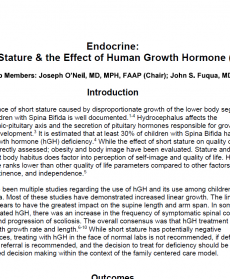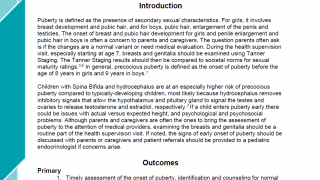Workgroup Members: Joseph O’Neil, MD, MPH, FAAP (Chair); John S. Fuqua, MD
Introduction
The incidence of short stature caused by disproportionate growth of the lower body segments among children with Spina Bifida is well documented.1-4 Hydrocephalus affects the hypothalamic-pituitary axis and the secretion of pituitary hormones responsible for growth and pubertal development.3 It is estimated that at least 30% of children with Spina Bifida have human growth hormone (hGH) deficiency.4 While the effect of short stature on quality of life has not been directly assessed; obesity and body image have been evaluated. Stature and subsequent body habitus does factor into perception of self-image and quality of life. However, body image ranks lower than other quality of life parameters compared to other factors such as pain, incontinence, and independence.5
There have been multiple studies regarding the use of hGH and its use among children with Spina Bifida. Most of these studies have demonstrated increased linear growth. The linear growth appears to have the greatest impact on the supine length and arm span. In some patients treated hGH, there was an increase in the frequency of symptomatic spinal cord tethering and progression of scoliosis. The overall consensus was that hGH treatment did improve both growth rate and length.6-10 While short stature has potentially negative consequences, treating with hGH in the face of normal labs is not recommended, if deficiency is suspected, referral is recommended, and the decision to treat for deficiency should be made using shared decision making within the context of the family centered care model.
Outcomes
Primary
- Identify individuals with Spina Bifida who are growth hormone deficient.
Secondary
- Improve quality of life by improving strength, mobility, body image, and health.
- Reduce morbidity and mortality secondary to obesity.
0-11 months
Clinical Questions
- At what post-conceptual age do pituitary-hypothalamic hormones become affected by Chiari malformation, hydrocephalus, or placement of shunts?
- Could growth during infancy and first three years be improved by use of hGH?
- Does the use of hGH worsen other comorbidities associated with Spina Bifida, such as scoliosis, tethered cord, or spasticity?
- What and when are the appropriate evaluations for use of hGH?
Guidelines
- Take frequent and accurate weight, length, and occipital frontal circumference measurements during infancy and early childhood.11
- Make referrals to physical therapy to maximize range of motion, strength, and functional mobility as appropriate for the developmental age. (clinical consensus) (Mobility Guidelines)
- Encourage breastfeeding and appropriate nutrition.11 (Nutrition Guidelines)
- Discuss issues surrounding growth of children with Spina Bifida with the family. (clinical consensus)
1-2 years 11 months
Clinical Questions
- At what post-conceptual age do pituitary-hypothalamic hormones become affected by Chiari malformation, hydrocephalus, or placement of shunts?
- Could growth during infancy and first three years be improved by use of hGH?
- Does the use of hGH worsen other comorbidities associated with Spina Bifida, such as scoliosis, tethered cord, or spasticity?
- What and when are the appropriate evaluations for use of hGH?
Guidelines
- Take frequent and accurate weight, length, and occipital frontal circumference measurements during infancy and early childhood.11
- Make referrals to physical therapy to maximize range of motion, strength, and functional mobility as appropriate for the developmental age. (clinical consensus) (Mobility Guidelines)
- Encourage breastfeeding and appropriate nutrition.11 (Nutrition Guidelines)
- Discuss issues surrounding growth of children with Spina Bifida with the family. (clinical consensus)
3-5 years 11 months
Clinical Questions
- While linear growth is impacted by the effects of the myelomeningocele, at which age does the length become most affected (pre-pubertal years, pubertal growth spurt, and puberty)?
- At what age is the short stature evaluation best initiated?
- Who should do the evaluation and where should the evaluation be conducted?
- Which parameters best predict a positive response to hGH?
- Is hGH only indicated where growth hormone deficiency is identified?
- Who should cover the cost of hGH?
- Are there eligibility limitations to hGH treatment, such as: normal development, shortened arm span, minimal skeletal deformities, level of spinal lesion, amount of paresis, syringomyelia, tethered cord, scoliosis, vertebral anomalies, contractures or advanced pubertal development, with or without documented growth hormone deficiency?
- Does hGH improve lipid or bone metabolism?
- Does hGH result in enough of a positive change in adult height to see improved self-esteem, reduced obesity, better muscle strength and bone density, and rehabilitation potential?
Guidelines
- Assess weight, height at each health supervision visit. 11 If height is not able to be measured using a stadiometer, it is recommended that a consistent parameter (such as arm span) should be measured and recorded. (clinical consensus)
- Have a discussion with the family about the expected height of the child, based on the limitations due to myelomeningocele and the parents’ height. (clinical consensus)
- Discuss the risks and benefits of hGH therapy with the parents. (clinical consensus)
- If concerns about growth arise, a referral to a pediatric endocrinologist is recommended for growth assessment, IGF-1, IGF Binding Protein-3, and GH stimulation tests. (clinical consensus)
- If hGH treatment is initiated, monitor pituitary function, scoliosis, tethering of spinal cord, growth velocity, and pubertal development. This may be done in collaboration with a pediatric endocrinologist. (clinical consensus)
6-12 years 11 months
Clinical Questions
- While linear growth is impacted by the effects of the myelomeningocele, at which age does the length become most affected (pre-pubertal years, pubertal growth spurt, and puberty)?
- At what age is the short stature evaluation best initiated?
- Who should do the evaluation and where should the evaluation be conducted?
- Which parameters best predict a positive response to hGH?
- Is hGH only indicated where growth hormone deficiency is identified?
- Who should cover the cost of hGH?
- Are there eligibility limitations to hGH treatment, such as: normal development, shortened arm span, minimal skeletal deformities, level of spinal lesion, amount of paresis, syringomyelia, tethered cord, scoliosis, vertebral anomalies, contractures or advanced pubertal development, with or without documented growth hormone deficiency?
- Does hGH improve lipid or bone metabolism?
- Does hGH result in enough of a positive change in adult height to see improved self-esteem, reduced obesity, better muscle strength and bone density, and rehabilitation potential?
Guidelines
- Assess weight, height at each health supervision visit.11 If height is not able to be measured using a stadiometer, it is recommended that a consistent parameter (such as arm span) should be measured and recorded. (clinical consensus)
- Have a discussion with the family about the expected height of the child, based on the limitations due to myelomeningocele and the parents’ height. (clinical consensus)
- Discuss the risks and benefits of hGH therapy with the parents. (clinical consensus)
- If concerns about growth arise, a referral to a pediatric endocrinologist is recommended for growth assessment, IGF-1, IGF Binding Protein-3, and GH stimulation tests. (clinical consensus)
- If hGH treatment is initiated, monitor pituitary function, scoliosis, tethering of spinal cord, growth velocity, and pubertal development. This may be done in collaboration with a pediatric endocrinologist. (clinical consensus)
13-17 years 11 months
There are no relevant clinical questions or guidelines for this age group. Please refer to younger age groups if needed.
18+ years
There are no relevant clinical questions or guidelines for this age group. Please refer to younger age groups if needed.
Research Gaps
- Since linear growth is impacted by the effects of Spina Bifida, at which age does the length become most affected?
- At what age should short stature evaluation be initiated?
- Does hGH improve lipid or bone metabolism?
- Does hGH result in enough of a positive change in adult height to see improved self-esteem, reduced obesity, better muscle strength and bone density, and rehabilitation potential?
- What are the condition-specific risks of hGH treatment in the population with Spina Bifida?
- Does fetal surgery improve linear growth or reduce the rates of hGH deficiency or precocious puberty?
- Who should cover the cost of hGH?
- At what post-conceptual age do pituitary-hypothalamic hormones become affected by Chiari malformation, hydrocephalus, or placement of shunts?
- Which parameters best predict a positive response to hGH?
- Are there eligibility limitations to treatment with hGH?
References
- Green SA, Frank M, Zackman M, Prader A. (1985). Growth and sexual development of children with myelomeningocele. Eur J. Pediatr. 146-148
- Duval‐Beaupere, G., Kaci, M., Lougovoy, J., Caponi, M. F., & Touzeau, C. (1987). Growth of trunk and legs of children with myelomeningocele. Developmental Medicine & Child Neurology, 29(2), 225-231.
- Löppönen, T., Saukkonen, A. L., Serlo, W., Tapanainen, P., Ruokonen, A., & Knip, M. (1997). Reduced levels of growth hormone, insulin-like growth factor-I and binding protein-3 in patients with shunted hydrocephalus. Archives of disease in childhood, 77(1), 32-37.
- Apkon SD, Grady R, Hart S, Lee A, et. Al. (2014). Advances in the care of Children with Spina Bifida. Advances in Pediatrics 61, 33-74.
- Bakaniene, I., Prasauskiene, A., & Vaiciene‐Magistris, N. (2016). Health‐related quality of life in children with myelomeningocele: a systematic review of the literature. Child: care, health and development, 42(5), 625-643.
- Trollmann, R., Dörr, H. G., Gröschl, M., Blum, W. F., Rascher, W., & Dötsch, J. (2002). Spontaneous nocturnal leptin secretion in children with myelomeningocele and growth hormone deficiency. Hormone Research in Paediatrics, 58(3), 115-119.
- Rotenstein, D., & Bass, A. N. (2004). Treatment to near adult stature of patients with myelomeningocele with recombinant human growth hormone. Journal of Pediatric Endocrinology and Metabolism, 17(9), 1195-1200.
- Trollmann, R., Strehl, E., Wenzel, D., & Dorr, H. G. (2000). Does growth hormone (GH) enhance growth in GH-deficient children with myelomeningocele?. The Journal of Clinical Endocrinology & Metabolism, 85(8), 2740-2743.
- Rotenstein, D., Reigel, D. H., & Lucke, J. F. (1996). Growth of growth hormone-treated and nontreated children before and after tethered spinal cord release. Pediatric neurosurgery, 24(5), 237-241.
- Rotenstein, D., & Breen, T. J. (1996). Growth hormone treatment of children with myelomeningocele. The Journal of pediatrics, 128(5), S28-S31.
- Hagan, J. F., Shaw, J. S., & Duncan, P. M. (2007). Bright futures: Guidelines for health supervision of infants, children, and adolescents. American Academy of Pediatrics.
Tags


